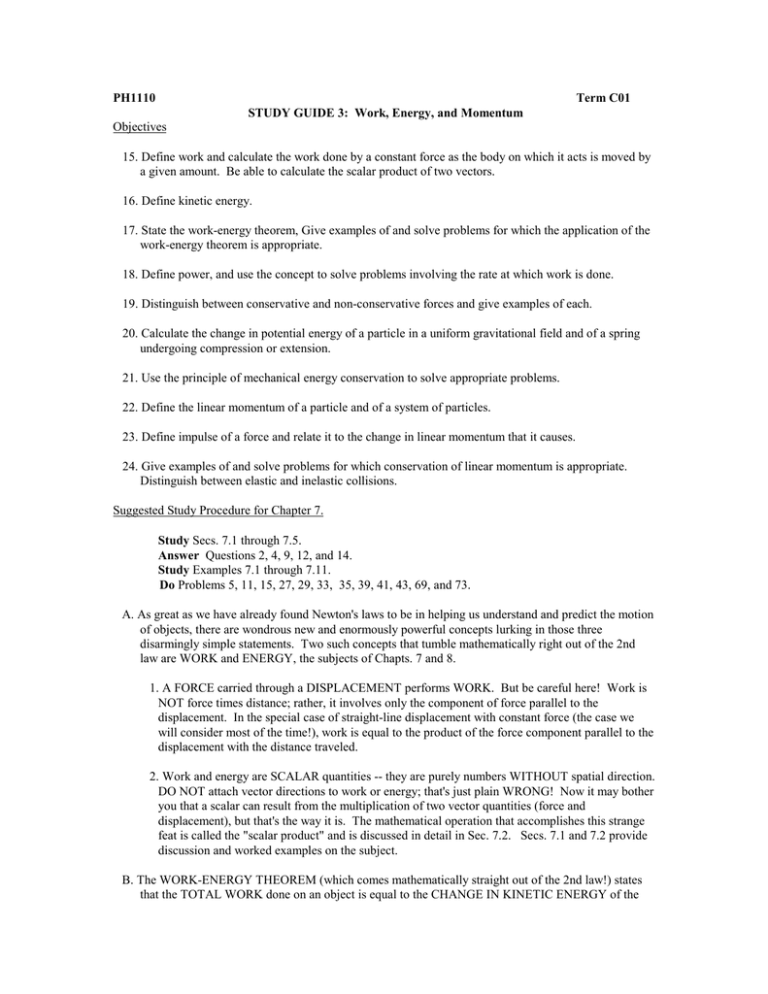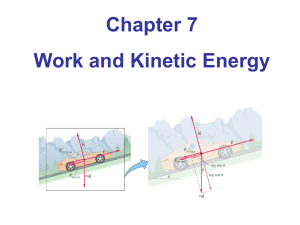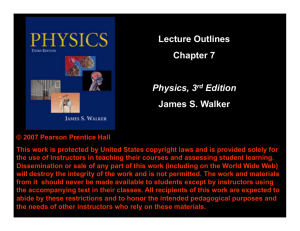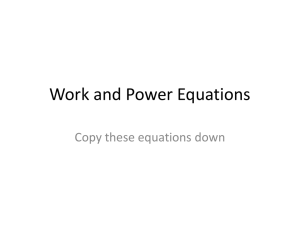Document 10282199
advertisement

PH1110 Term C01 STUDY GUIDE 3: Work, Energy, and Momentum Objectives 15. Define work and calculate the work done by a constant force as the body on which it acts is moved by a given amount. Be able to calculate the scalar product of two vectors. 16. Define kinetic energy. 17. State the work-energy theorem, Give examples of and solve problems for which the application of the work-energy theorem is appropriate. 18. Define power, and use the concept to solve problems involving the rate at which work is done. 19. Distinguish between conservative and non-conservative forces and give examples of each. 20. Calculate the change in potential energy of a particle in a uniform gravitational field and of a spring undergoing compression or extension. 21. Use the principle of mechanical energy conservation to solve appropriate problems. 22. Define the linear momentum of a particle and of a system of particles. 23. Define impulse of a force and relate it to the change in linear momentum that it causes. 24. Give examples of and solve problems for which conservation of linear momentum is appropriate. Distinguish between elastic and inelastic collisions. Suggested Study Procedure for Chapter 7. Study Secs. 7.1 through 7.5. Answer Questions 2, 4, 9, 12, and 14. Study Examples 7.1 through 7.11. Do Problems 5, 11, 15, 27, 29, 33, 35, 39, 41, 43, 69, and 73. A. As great as we have already found Newton's laws to be in helping us understand and predict the motion of objects, there are wondrous new and enormously powerful concepts lurking in those three disarmingly simple statements. Two such concepts that tumble mathematically right out of the 2nd law are WORK and ENERGY, the subjects of Chapts. 7 and 8. 1. A FORCE carried through a DISPLACEMENT performs WORK. But be careful here! Work is NOT force times distance; rather, it involves only the component of force parallel to the displacement. In the special case of straight-line displacement with constant force (the case we will consider most of the time!), work is equal to the product of the force component parallel to the displacement with the distance traveled. 2. Work and energy are SCALAR quantities -- they are purely numbers WITHOUT spatial direction. DO NOT attach vector directions to work or energy; that's just plain WRONG! Now it may bother you that a scalar can result from the multiplication of two vector quantities (force and displacement), but that's the way it is. The mathematical operation that accomplishes this strange feat is called the "scalar product" and is discussed in detail in Sec. 7.2. Secs. 7.1 and 7.2 provide discussion and worked examples on the subject. B. The WORK-ENERGY THEOREM (which comes mathematically straight out of the 2nd law!) states that the TOTAL WORK done on an object is equal to the CHANGE IN KINETIC ENERGY of the object (final minus initial). What's so great about that, you may ask? Well, for one thing, a scalar equation is invariably easier to work with than a vector equation. For another, we're concerned with speeds of the object only at the beginning and at the end of the displacement, and not anywhere in between. If you know an object's speed at the beginning and end of the object's displacement, you immediately know how much total work was done on the object. If you know the total work done, you immediately know the change in kinetic energy. The power of this generalization in analyzing motion is demonstrated repeatedly in many of the problems at the end of the chapter. C. The one non-constant force we consider in PH 1110 is the spring force, discussed in Sec. 7.3. Study this section carefully to see how work is properly computed when the force varies linearly with displacement. D. POWER, the RATE at which WORK is performed, is also a scalar quantity. Read about it in Sec. 7.5. Suggested Study Procedure for Chapter 8. Study Secs. 8.1 through 8.5, and 8.8. Answer Questions 2, 6, 11, and 13. Study Examples 8.2 through 8.10. Do Problems 11, 13, 15, 17, 21, 27, 29, 31, 39, 53, and 57. A. Believe it or not, Chapt. 8 is just one long series of applications of the Work-Energy Theorem, even though it may not look like it! As you found in Chapt. 7, the TOTAL work is just the (scalar!) SUM of the work done by each individual force. Because the work done by CONSERVATIVE FORCES (the gravitational and spring forces) depends only on the endpoints of the displacement (NOT how we got from the initial to final point!), we can pull them out of the TOTAL WORK and express them in terms of initial and final points. The way we like to express the theory of Chapt. 8 is: ½mvi2 + mghi + ½ksi2 + Wother = ½mvf2 + mghf + ½ksf2 For some reason, S & B never quite express the theory in this compact form, and as a result, Chapt. 8 may seem more complicated than it really is. Nonetheless, this one equation is what Chapt. 8 is all about, and Lecture #10 will be aimed at making its application crystal clear! Suggested Study Procedure for Chapter 9. Study Secs. 9.1 through 9.5; Skim 9.6. Answer Questions 2, 3, 4, and 8. Study Examples 9.1 through 9.11. Do Problems 9, 11, 17, 21, 27, 29, 31, 33, 35, 57, and 71. A. Two more extremely powerful concepts that tumble mathematically out of Newton's 2nd law are IMPULSE and MOMENTUM. IMPULSE is a FORCE acting through TIME -- a sort of product of force and time, with units of newton-seconds. MOMENTUM is the product of mass with velocity. According to the 2nd law, the IMPULSE received by an object equals the CHANGE OF MOMENTUM of the object. 1. Note the similarity with the form of the Work-Energy Theorem (where TOTAL WORK equals the CHANGE IN KINETIC ENERGY). Also note that, just as in the case of work-energy, we are concerned with a change from an initial to a final state, without worrying about precisely what happened in between. That's the real power of this IMPULSE-MOMENTUM stuff, just as in the case of WORK-ENERGY. 2. But PLEASE also note the PROFOUND DIFFERENCES! For example, impulse and momentum are VECTOR quantities, meaning that direction is an integral attribute of each, and problem solutions will require use of components. Nonetheless, this complication is more than offset by the power of the approach, as illustrated in Secs. 9.1 and 9.2. B. Impulse-Momentum is especially important in considering the COLLISION of two or more objects. Here's why! Remember Newton's 3rd law? All those action-reaction pairs of forces between interacting objects are equal and opposite. Thus, if you add up all the impulses resulting from those action-reaction pairs, the sum must be ZERO! That is, the NET IMPULSE must be ZERO. Zero net impulse requires that the TOTAL MOMENTUM of the system of two or more objects NOT CHANGE during the collision. In such cases, we say that momentum is a CONSERVED QUANTITY (a constant). Secs. 9.3 through 9.5 show how this important principle of CONSERVATION OF MOMENTUM is applied to the solution of collision problems. C. When two or more objects collide in the absence of net external force, the total momentum of the system of objects is ALWAYS AND NECESSARILY CONSERVED. The total kinetic energy of that system of objects, however, is seldom the same afterwards as it was before. In those RARE situations where kinetic energy is conserved, we call the collision "elastic." NEVER assume that a collision is elastic UNLESS you are told that it is OR you calculate that it is after you have solved the problem using momentum conservation. All other collisions where the kinetic energy changes during the collision are called "inelastic." Read all about it in Secs. 9.4 and 9.5. HOMEWORK ASSIGNMENTS FOR STUDY GUIDE 3. Homework Assignment #8 - due in lecture Monday, Feb 5. Yes, we know that we have not yet touched on this material in lecture, but these are fairly straightforward exercises, so you should be able to dig out the necessary theory on your own! HW #8-1: Prob. 7-2, PLUS draw a free-body diagram of the cart AND draw a sketch of the situation, including a coordinate system, summarizing the key details at issue here. THIS IS SOMETHING YOU SHOULD CONTINUE TO DO WITH ALL PROBLEMS THROUGH TO THE END OF THE COURSE. HW #8-2: Prob. 7-6. (Please remember, as specified in the previous problem, to include the free-body diagram and sketch of the situation!) HW #8-3: Prob. 7-14. Express answer in MKS units. Homework Assignment #9 - due in lecture Wednesday, Feb 7. HW #9-1: A 5.00-kg block of ice slides 1.50 m down as inclined plane that slopes downward at an angle of 20o below the horizontal. a) Calculate the final speed of the block, given that its initial speed is zero. b) Calculate the final speed of the block, given that its initial speed is 2.50 m/s. c) Sand is now sprinkled on the plane to provide a constant amount of friction. Given that the block starts from rest and takes three times longer (than in part (a)) to travel 1.50 m, calculate the coefficient of kinetic friction for this situation. HW #9-2: A luggage handler pulls a 20.0-kg suitcase up a ramp inclined at 25o above the horizontal with a force of 145 N that acts parallel to the ramp. The coefficient of kinetic friction between the ramp and the suitcase is µk= 0.300. If the suitcase travels 4.60 m along the ramp, calculate a) the work done on the suitcase by the luggage handler; b) the work done on the suitcase by the gravitational force; c) the work done on the suitcase by the normal force; d) the work done on the suitcase by the friction force; and e) the total work done on the suitcase. f) Given that the velocity of the suitcase at the bottom of the ramp is 1.10 m/s upward along the ramp, determine the speed after the 4.60 m displacement. HW #9-3: A woman stands in an elevator that has a constant upward acceleration while the elevator travels upward a distance of 15.0 m. During the 15.0-m displacement, the normal force exerted by the elevator floor does 8.25 kJ of work on her and gravity does –7.35 kJ of work on her. a) Determine the mass of the woman. b) Determine the magnitude of the normal force that the elevator floor exerts on her. c) Determine the acceleration of the elevator. Homework Assignment #10 - due in lecture Friday, Feb 9. HW #10-1: Prob. 8-26. (By way of a hint, we note that “barely makes it around the loop” does not mean that v is almost zero at the top; rather, the car barely maintains contact with the tracks as it coasts along the top of the loop.) HW #10-2: A 2.00-kg block is pushed against a spring of negligible mass and force constant k = 400 N/m, compressing it 0.220 m. When the block is released, it moves along a frictionless, horizontal surface and then up a frictional incline with slope 37.0o and coefficient of kinetic friction of µk = 0.200. a) Calculate the speed the block would have as it slides along the horizontal surface after having left the spring. b) Determine the distance the block slides up the incline before coming momentarily to rest. HW #10-3: Prob. 8-74. (If you have trouble with this general case, try first the special case of the system starting from rest, then generalize.) Homework Assignment #11 - due in lecture Monday, Feb 12. HW #11-1: Prob. 9-6. HW #11-2: Prob. 9-12, PLUS c) calculate the work done on the ball during the collision. HW #11-3: Prob. 9-38, PLUS c) calculate the impulse received by each musket ball during the collision. Homework Assignment #12 - due in lecture Wednesday, Feb 14. HW #12-1: Prob. 9-34, PLUS c) calculate the impulse received by each puck during the collision. HW #12-2: Prob. 9-26. HW #12-3: A railroad handcar is moving along straight frictionless tracks. In each of the following cases, the car initially has a total mass (car and contents) of 200 kg and is traveling east with a speed of 5.00 m/s. Determine the final velocity of the car in each case, assuming that the handcar does not leave the tracks: a) A 30.0-kg mass is thrown straight out the side of the car at a speed of 2.00 m/s as viewed from the car. b) A 30.0-kg mass is thrown backward out of the car with a speed of 5.00 m/s relative to the initial motion of the car. c) A 30.0-kg mass is thrown into the car with a speed of 6.00 m/s relative to the ground and opposite in direction to the initial motion of the car. d) A 30.0-kg mass, originally motionless with respect to the ground, drops onto the handcar and sticks to it.







